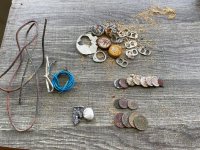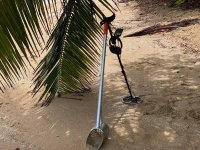Kory Man X
New Member
- Joined
- Jul 7, 2020
- Messages
- 15
I am a new member here on the fourm as you can see.
I have been scrolling through and searching through this form, gaining knowledge so thank you to everybody who has answered my questions and organized this form for necessary information.
Thank you to Myers Metal Detectors in Florida for their great customer service.
I have never metal detected in my life but always wanted to and my new move to Puerto Rico, it was a must. I ordered the Equinox 800 and I’m glad I did. I can tell this machine knows how to find things and as soon as I get better at using it I’m going to be finding treasures galore.
Here is my first day finds.
Found some wiring which I believe to be copper so that’s worth some money.
Two odd finds, one that I believe is a fish sinker and the other one I have no idea what it is but I’m going to clean it up and find out.
And about $1.40 in clad all copper and Nickle, few zinc. No silver
And of course lots of tabs and tops.
For all of you veterans out there using the 800 what settings are you using on the beach to avoid bottle caps and tabs?
Thank you to everyone!
I have been scrolling through and searching through this form, gaining knowledge so thank you to everybody who has answered my questions and organized this form for necessary information.
Thank you to Myers Metal Detectors in Florida for their great customer service.
I have never metal detected in my life but always wanted to and my new move to Puerto Rico, it was a must. I ordered the Equinox 800 and I’m glad I did. I can tell this machine knows how to find things and as soon as I get better at using it I’m going to be finding treasures galore.
Here is my first day finds.
Found some wiring which I believe to be copper so that’s worth some money.
Two odd finds, one that I believe is a fish sinker and the other one I have no idea what it is but I’m going to clean it up and find out.
And about $1.40 in clad all copper and Nickle, few zinc. No silver
And of course lots of tabs and tops.
For all of you veterans out there using the 800 what settings are you using on the beach to avoid bottle caps and tabs?
Thank you to everyone!





